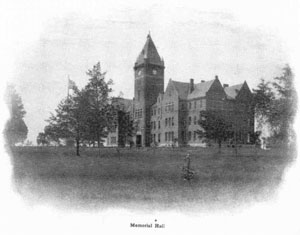
Cumberland University
Established as Cumberland College at Lebanon in 1842 under the patronage of the Cumberland Presbyterian Church, Cumberland University received a charter as a university in 1843. Except for the period from 1962 to 1982, when the name was officially Cumberland College of Tennessee, the institution has operated continuously as Cumberland University and is the oldest institution of higher education in the central South operating under its original chartered name. Shortly after its founding, Cumberland University occupied a large new Greek Revival-style building. Robert L. Caruthers, lawyer, soldier, jurist, and congressman, took a leading role in the subscription drive that produced ten thousand dollars for the new college; he became the first president of the board of trustees. In 1847 trustees at Cumberland University established a school of law. It opened a theological school and a school of engineering in 1853. By 1859 the law school was among the largest in the United States. Cumberland University can be justly proud of its many distinguished alumni, including Myles Horton, the founder of Highlander Folk School; James L. Bomar, president of Rotary International; John Edgerton, president of the National Association of Manufacturers; Secretary of State Cordell Hull, winner of the Nobel Prize for Peace; Congressional Medal of Honor winner (Vietnam) Robert Ray; and three Pulitzer Prize-winning authors.
Activities during the Civil War devastated Cumberland University. Military action in 1864 produced a fire that destroyed the main building, leaving only two Corinthian columns standing. W. E. Ward, an alumnus and founder of Ward Seminary, returned to the ruins and wrote on a column with a piece of charred wood E Cineribus Resurgam (“From Ashes I Shall Arise”). The words and the Phoenix, the mythical bird ever born again, became the motto and emblem of the university. In 1871 the law school adopted a one-year program of instruction and a new model for legal education. An outstanding list of trial lawyers emerged from the stern discipline of the university’s program.
In the twentieth century, the two World Wars took their toll. In 1942 the Second Army took over Memorial Hall as Maneuver Director Headquarters to direct the training of over eight hundred thousand soldiers for the conquest of Europe. While the operation was underway, the tents of ten thousand soldiers covered the fifty-acre campus.
In 1946 officials transferred the school to the sponsorship of the Tennessee Baptist Convention. At that time, it also merged with the Tennessee College for Women in Murfreesboro. In 1951, after the convention acquired other property in Nashville, Cumberland returned to its former independent board. Only the law school operated until 1955, when Cumberland reopened a two-year liberal arts college. Cumberland became a member of the Southern Association in 1962. With the addition of a School of Nursing and graduate programs in education and other areas, the school resumed under the university designation in 1982. From 1963 to the end of the century, Cumberland University constructed a number of new buildings and athletic facilities including the Doris and Harry Vise Library that includes the Stockton historical archives. Dr. Clair Martin became president of Cumberland University in 1995; Dr. Charlene M. Kozy is presently the interim president. The school’s 2000 fall enrollment was 1,250.



